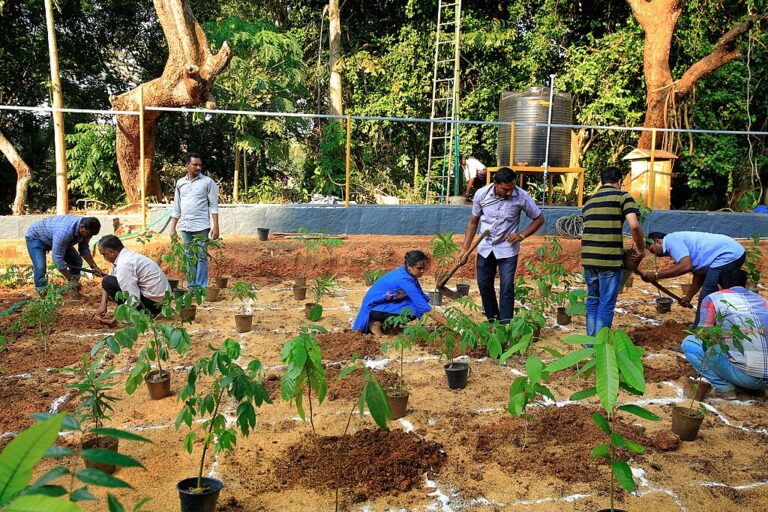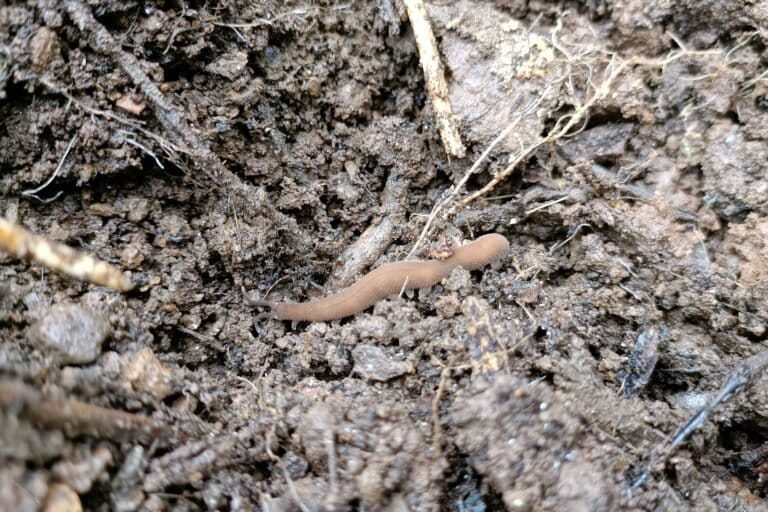- Women farmers are reviving traditional organic farming practices and using backyard concoctions to keep away pests from their paddy fields in the Uttar Dinajpur district of West Bengal.
- One method integrates ducks with paddy cultivation. Ducks wade through paddy fields, eating insects and weeds, and their droppings in turn act as natural manure.
- The method also decreases methane emissions from paddy fields, because the ducks stir up the soil using their beaks and feet, creating an aerated soil environment that does not generate methane.
- The traditional chemical-free farming yields 6 quintals per bigha (about 0.13 hectare), as against 8 quintals from chemical farming. But with almost zero inputs, and additional income from the ducks, the method yields higher profit margins.
At the crack of dawn, Lipi Basak and her sisters Smriti and Mamti are already out of their home, with a group of quacking ducks ahead of them. It is raining. The road is muddy with small puddles. But this does not deter the feisty young women from reaching their ultimate destination — paddy fields about a kilometre away from their home.
Once there, the ducks, altogether eighteen of them, merrily glide onto the paddy ponds flapping their wings, wading past the tender saplings that are about 1.5 feet-2 feet tall.
“They have been brought here with a purpose,” said Lipi, a home maker turned neo-farmer from Keotal village in Uttar Dinajpur district of West Bengal.
“The ducks eat up the harmful pests and weeds from our fields, their droppings make the soil fertile. This saves us from using chemical fertilisers, herbicides and insecticides and their escalating costs,” she informed.

Smriti and Mamti however caution that the ducks should not be released until at least 20- 25 days after transplanting the paddy; otherwise they may end up feeding on or damaging their young rice seedlings. The roots of the saplings prior to their release, need to be developed and firmly entrenched to the soil, they said.
For the Basak sisters in their twenties, work has however not been easy. They belong to a large joint family of farmers and for them to break traditional shackles and step out of their home three years ago was challenging. “We were mocked at by our fellow villagers and family members who thought we have gone mad,” they recalled.
Such comments were not made simply because they are women and agriculture is still predominantly a male domain in India, but primarily because they chose not to follow the beaten track of high yield chemical intensive cultivation. The sisters decided to take up organic farming integrated with native, climate friendly practices.
Woman power through organic farming
The transition went through various trials and errors for these upcoming women farmers. During the first year, their output was not satisfactory either, which made their family members further critical on the future of their organic farming.
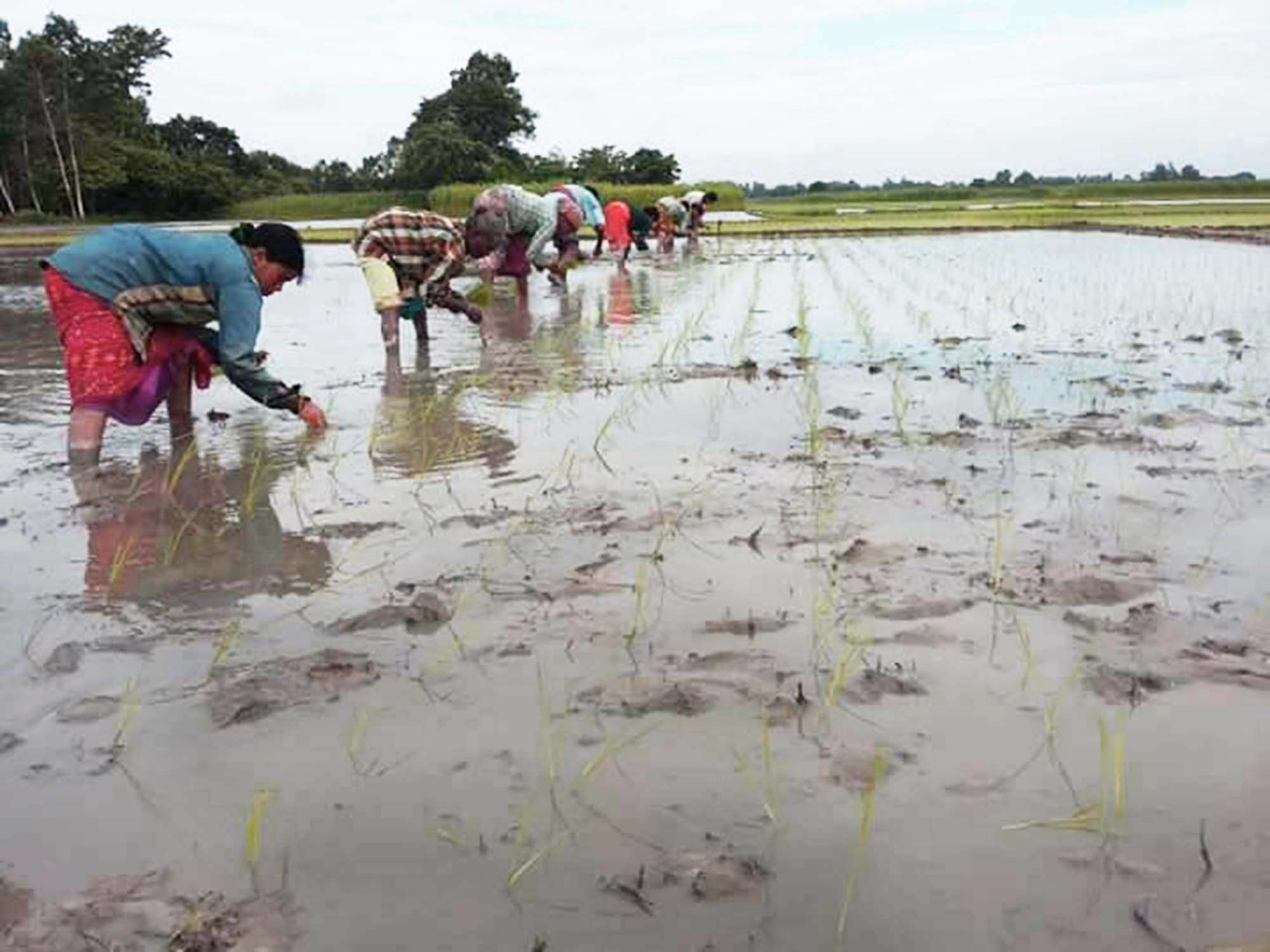
“However, we held on to our convictions. Within our limited resources and capacity, we succeeded in raising about 35-40 quintals of organically grown paddy in 5 bighas of land during the last season,” they stated. (One quintal is 100 kg and Bigha is a traditional unit for land measurement in India, which is equivalent to 0.66 hectares). This was further diversified with cultivation of seasonal vegetables and other crops.
Similar success stories of change are being scripted by at least 75 women in Keotal and its neighbouring villages of Dohole, Abhinagar, Uttar Palaibari and Balaoul under Itahar block of Uttar Dinajpur district in the state. They have named their group as “Narishakti Jaibochasi Mahila Dal” (NJMD) which means, “woman power through organic farming”.
Largely a self-driven organisation, today its members have pooled their land together, cultivating chemical free paddy and other crops in 45 bighas (6.02 hectares) of land. “Our productivity figures at about 6 quintals / bigha (0.13 hectare) as against the high yield crop average of 8 quintals in the same area. But considering our low cost/zero cost inputs in comparison to the chemically grown rice, our profits per bigha is higher,” claims Mousumi Basak, who leads the fiery brigade of women farmers.
A high school dropout, she is a storehouse of soil friendly and pest preventing natural recipes. “My lessons are not from books, but based on our traditions that is replete with such indigenous knowledge,” she says. “But unfortunately, they have faded into oblivion following the advent of green revolution since the 1960s leading to monocropping, done with constant use of chemical pesticides and fertilizers,” she rues.
And what shaped her thoughts further, introducing her to the whole new world of “clean” farming was the Forum For Indigenous Agricultural Movement (FIAM), a grass root organization comprising youths, farmers, environmentalists and experts in the north and south Dinajpur districts of north Bengal.
As an active member of FIAM since the past six years, she is a regular participant in its training workshops, which are honing her skills on the preparation of natural pest repellants, fertilisers and nitrogen fixers in soil. After her training, when she returned to her village eager to propagate the knowledge she had gained, there were practically no takers. Nearly 95 percent of the farmers believed in and wanted to continue with chemical paddy cultivation.

When the men did not heed her, Mousumi went ahead to motivate women homemakers instead. Accompanied by a couple of likeminded persons, she went door to door and persuaded them to go organic at least in the best interests of their family’s health. While she began by preparing natural pesticides and fertilisers at home, over a period of time, she managed to inspire young homemakers as Lipi, Mamti and others to become members of her group.
Her efforts are paying off with the revival of various indigenous and organic techniques of cultivation by her group members. Paddy duck farming for instance is being practiced by at least 40 out of 75 members of NJMD.
Watching the ducks and paddy ‘grow together’
Upholding the benefits of paddy duck farming, Ardhendu Sekhar Chatterjee, an expert on sustainable, climate friendly agricultural practices says, “Integrating ducks with paddy cultivation is especially suitable for small holder farmers to produce organically grown rice at low cost.” Chatterjee is the founder of Development Research Communication and Services Centre (DRCSC), a West Bengal based nonprofit, which has been working across India on sustainable agricultural practices over the past three decades.
He however points out that the paddy field should be able to retain at least six to nine inches of rainwater for at least 100 days and seedlings should be planted at least 15 centimetres apart for ducks to wade through between them.
“The ducks and seedlings should be around the same age and it would be a pleasure to watch them grow together,” he said.
This integrated system according to him creates a symbiotic relation between them, using the same natural resources. These aquatic birds get a nutritious diet by feeding on various insects and weeds from the paddy fields, which in turn get enriched by their droppings.
“All these factors lead to increased rice productivity by at least 10 to 20 percent with plants found to grow taller bearing more number of grains per panicle [stalk],” he said.
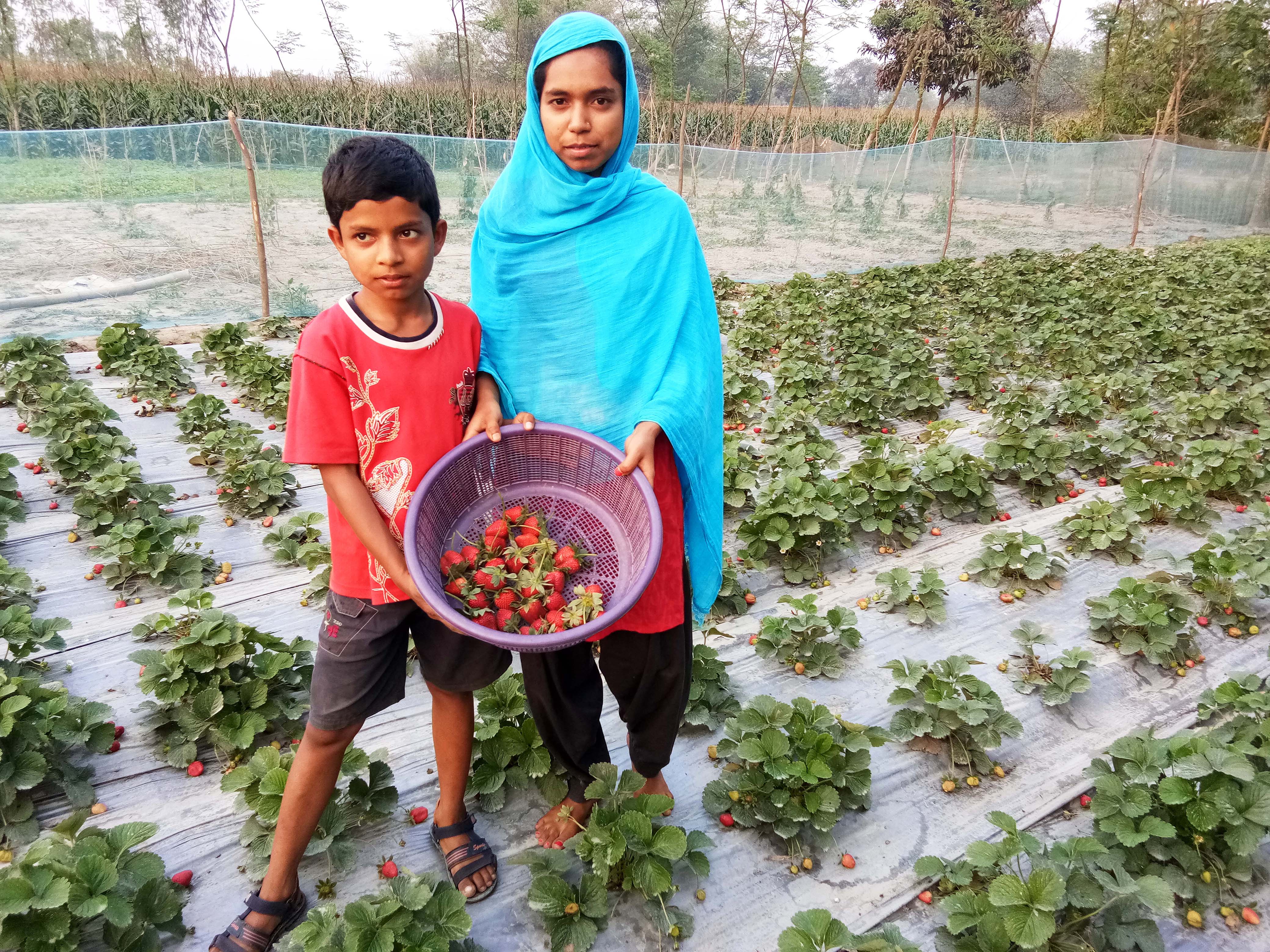
Ploughing ducks reduce methane emissions
But most importantly, according to Chatterjee, rice-duck technology reduces emission of methane, the greenhouse gas causing global warming.
Ducks moving through the fields plough the water laden land with their beaks, till it becomes soft and muddy. This loosens up the soil, making it more aerated, thereby increasing dissolved oxygen in the surface soil and water of paddy fields. This enhances aerobic decomposition of soil organic matter. Methane gas on the other hand is released, when such activities take place in anaerobic condition or in absence of oxygen. Hence duck paddy system is an ideal solution to fight climate change locally and ensure food security, he said.
Upbeat with the efforts of the women’s group NJMD in this regard, FIAM has agreed to provide ten ducks to each of its ten members this season, with the condition that they have to give back twelve ducks to the organisation, for further distribution to new members.
Such support and encouragement have further buoyed the activities of the women farmers in their villages.
Backyard ‘astras’
It is late evening and at least a dozen of the women farmers have assembled in Mousumi’s backyard after completing their household chores. Some have brought neem leaves, grinding stones, others have arrived with fresh dung and urine of cow etc. Soon four of them get busy in preparing a paste of about two kilos of fresh neem leaves; others are mixing up a kilo of fresh cow dung with two litres of its urine.
Mousumi explained they are preparing “Neemastra” (meaning weapon of neem) an effective pest repellant, whose respective proportions have to be maintained for best results. The ingredients, especially the leaves of the neem tree (Azadirachta indica) are a powerful natural biological insecticide, which do not damage the soil or agro-ecosystem.
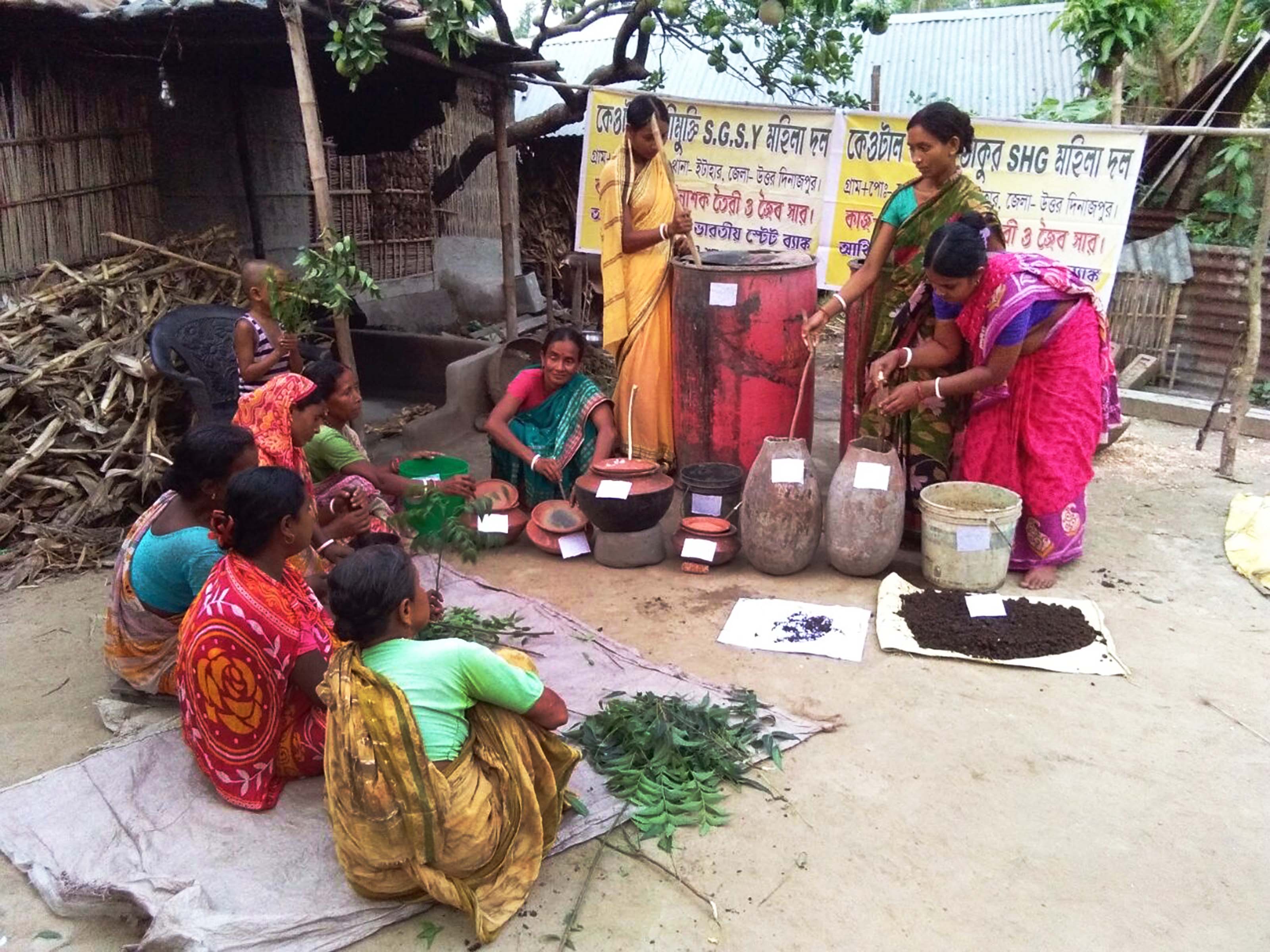
Soon, the contents are emptied into a medium sized earthen container and stirred vigorously, and allowed to rest for 24 hours. And lo and behold! The powerful “Neem weapon” is ready to be sprayed in a concentration of 20 milliliters with one litre of water. Once the plants are sprayed with the solution, the harmful pests “automatically” move away, explain the members.
Interestingly, these women seem to have a number of other “weapons” under their belt. With fanciful names as Agniastra, Brahmastra, Amritjal, Sanharak, Panchogabba, Sanjeeba, these organic concoctions have specific compositions to serve definite purposes.
“Our naturally prepared pesticides do not compromise on human health for the sake of high yield,” said Rumpa Basak and Jhulu Burman, two woman farmers from the group. Agniastra (fire arm) for instance is one of the most powerful pesticides used by them. It is prepared with extremely bitter leaves of wild water spinach, very hot green chilies, garlic, besides other ingredients, which are boiled in water till the solution is reduced to half. It is then strained and ready to use. Various other natural items as raw turmeric, molasses, curd, gram flour, added to poultry litter or mixed and stirred up in varying proportions are also being used by them.
Impressed with their efforts, the district agricultural department has also inducted them in their training programmes and workshops. Sanjay Saha, Assistant Director of Agriculture, Raiganj Block who supervises their activities said the members are made to understand that such low cost methods are high on environmental benefits.
They revive soil life, increase organic matter, carbon content and its water retention capacity, reduce greenhouse gas emissions, improve profitability by maintaining yields and thereby revitalizes the farming community as a whole. “In short, such regenerative traditional organic farming is integral to climate solution,” said Saha.
Meanwhile, it is not just the technical experts who are testifying their work, but even their own family members and villagers are beginning to take notice. Said Narugopal Basak, a conventional farmer from Keotal, whose wife happens to be a member of NJMD, “Though I am still not sure how far organic farming can sustain us, I am willing to give it a try.” Considering the health benefits and low cost inputs, he has decided to devote at least one out of his 20 bighas for chemical free cultivation.
With this, the victory of NJMD does not seem very far. As more women break free from chemical intensive agriculture to join the organic farming bandwagon, it becomes truly symbolic of new age women’s liberation for a worthy cause: to save the environment from impacts of climate change and add to food security.
(The story is produced with support from the Earth Journalism Network)
The banner image has been replaced since the publication of the story.










